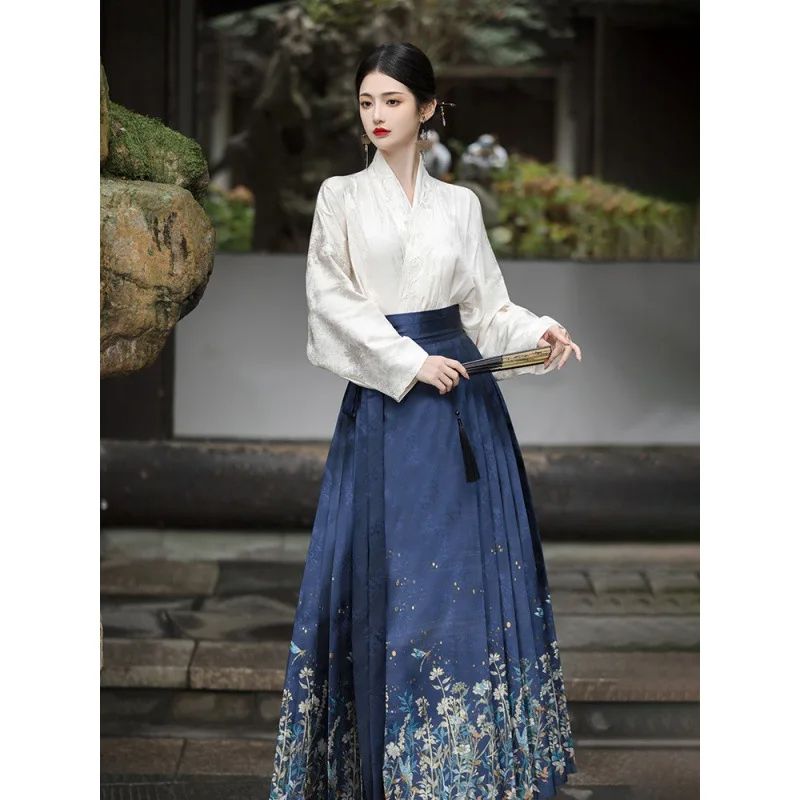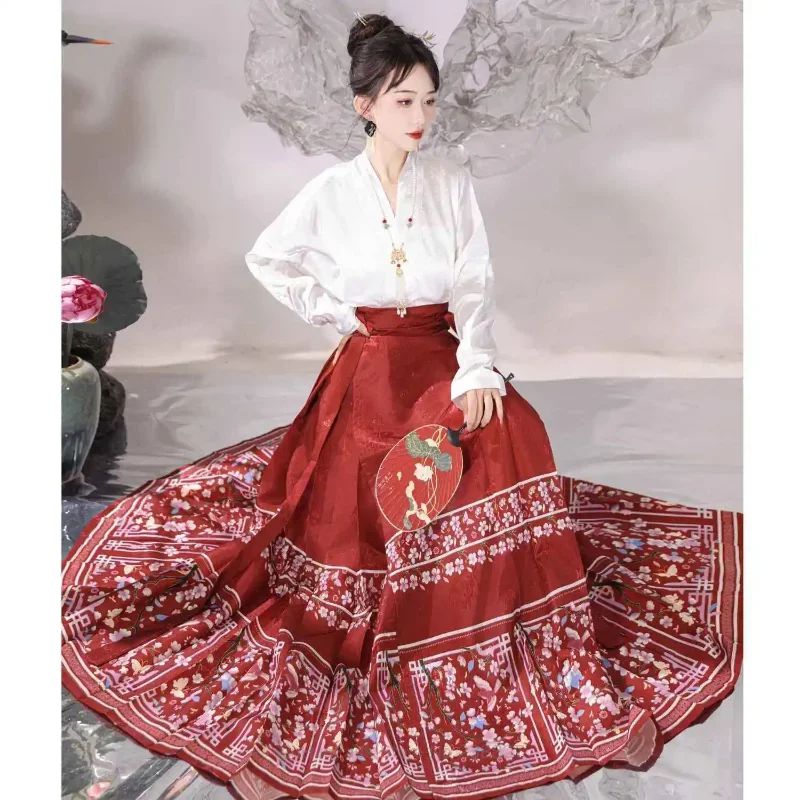The History and Evolution of Mamianqun
Origins in the Ming Dynasty
Mamianqun, the Chinese horse-face skirt, holds a profound cultural significance that has evolved over centuries. Originating in the Ming dynasty, it was initially worn by court ladies and noblewomen as a symbol of status and elegance. The skirt’s distinctive shape, resembling a horse’s face, was believed to bring good fortune and ward off evil spirits.

Adoption in the Qing Dynasty
During the Qing dynasty, mamianqun became more widely adopted by women of all social classes. It was often paired with a long robe, creating a graceful and modest silhouette. The skirt’s intricate embroidery and embellishments reflected the wearer’s wealth and artistry.
Revival in the 20th Century
In the 20th century, mamianqun experienced a revival as a symbol of Chinese cultural heritage. It was featured in traditional performances and became a popular choice for weddings and other special occasions. Today, mamianqun continues to be celebrated as a testament to Chinese craftsmanship and cultural identity.
Symbolism of the Horse-Face Shape
The horse-face shape of mamianqun is not merely decorative but also symbolic. The horse is revered in Chinese culture as a symbol of strength, speed, and endurance. By incorporating the horse’s face into the skirt, wearers sought to embody these qualities.
Construction and Traditional Values
Furthermore, the skirt’s construction reflects traditional Chinese values. The waistband, often made of silk or brocade, represents the wearer’s connection to the earth. The pleated fabric, which flows gracefully around the legs, symbolizes the fluidity and adaptability of women.
Folklore and Mythology
Mamianqun has also played a role in Chinese folklore and mythology. In the legend of the Eight Immortals, the female immortal He Xiangu is depicted wearing a horse-face skirt. This association with the divine further enhances the skirt’s cultural significance.
Conclusion
In conclusion, mamianqun, the Chinese horse-face skirt, is a multifaceted garment that embodies cultural values, symbolism, and artistry. Its evolution over centuries reflects the changing social and cultural landscape of China. Today, mamianqun remains a cherished symbol of Chinese heritage, celebrated for its beauty, symbolism, and enduring cultural significance.
The Symbolism and Meaning of the Horse-Face Motif
Mamianqun, the Chinese horse-face skirt, is a captivating garment steeped in cultural significance. Its distinctive horse-face motif, characterized by an elongated, stylized horse head, has been an integral part of Chinese folklore and art for centuries.

Symbol of Strength and Vitality
The horse-face motif symbolizes strength, vitality, and fertility. In ancient Chinese mythology, horses were revered as celestial beings associated with the sun and wind. Their swiftness and power made them symbols of military prowess and success. The horse-face skirt, therefore, embodied these qualities, bestowing upon its wearer protection and good fortune.
Protective Aspects
Furthermore, the horse-face motif was believed to ward off evil spirits. The horse’s head, with its piercing eyes and open mouth, was thought to frighten away malevolent forces. This protective aspect made the mamianqun a popular choice for young women, who wore it as a talisman against harm.
Social Significance
The horse-face skirt also held social significance. It was primarily worn by unmarried women, symbolizing their purity and eligibility for marriage. The elaborate embroidery and intricate designs on the skirt showcased the wearer’s skill and artistry, making it a desirable garment for attracting potential suitors.
Ethnic Identity
Over time, the mamianqun evolved into a symbol of ethnic identity. It became particularly associated with the Miao people, an ethnic minority group in southwestern China. The Miao women’s horse-face skirts are renowned for their vibrant colors, intricate embroidery, and unique horse-face motifs. Each skirt is a testament to the Miao people’s rich cultural heritage and artistic traditions.
Contemporary Celebrations
In contemporary China, the mamianqun continues to be celebrated as a cultural treasure. It is worn during festivals, performances, and special occasions, showcasing the enduring legacy of Chinese folklore and the significance of the horse-face motif. As a symbol of strength, fertility, and protection, the mamianqun remains a cherished garment that connects the past with the present, preserving the cultural heritage of the Chinese people.
Mamianqun in Contemporary Fashion and Culture
Mamianqun, the Chinese horse-face skirt, is a vêtement steeped in cultural significance and aesthetic beauty. Its origins can be traced back to the Ming dynasty, where it was worn by women of the imperial court. The skirt’s distinctive silhouette, characterized by its high waist and flared hem, resembles the face of a horse, hence its name.

Interprétations modernes
Beyond its historical roots, the mamianqun has also found a place in contemporary fashion and culture. Designers have reinterpreted the traditional form, incorporating modern materials and embellishments to create garments that are both stylish and evocative of the past. The skirt’s versatility allows it to be paired with a wide range of tops and accessories, making it suitable for various occasions.
Importance culturelle
The cultural significance of the mamianqun extends beyond its aesthetic appeal. In Chinese folklore, the horse is a symbol of strength, speed, and good fortune. By wearing a mamianqun, women were believed to embody these qualities, attracting prosperity and happiness. The skirt also served as a social marker, indicating the wearer’s status and wealth.
Symbol of Heritage
In modern times, the mamianqun has become a symbol of Chinese cultural heritage. It is often featured in traditional festivals, performances, and cultural events. By wearing the skirt, individuals connect with their ancestors and celebrate their cultural identity.
Artistic Inspiration
Furthermore, the mamianqun has inspired contemporary artists and designers. Its unique shape and symbolism have been incorporated into various art forms, including paintings, sculptures, and fashion accessories. By reinterpreting the traditional garment, artists explore themes of cultural identity, history, and modernity.
Conclusion
In conclusion, the mamianqun is a garment that transcends time and fashion. Its cultural significance, rooted in Chinese history and folklore, continues to resonate in contemporary society. Through its presence in fashion, art, and cultural events, the mamianqun serves as a bridge between the past and the present, connecting individuals with their heritage and inspiring creativity.
